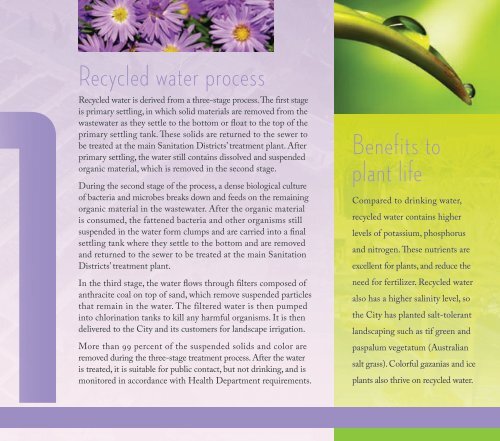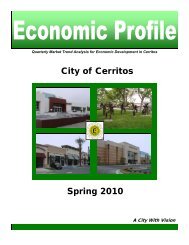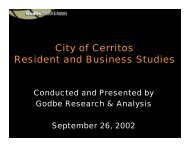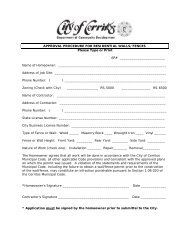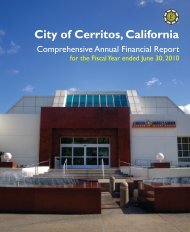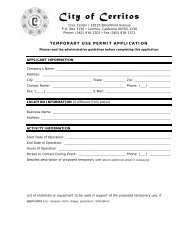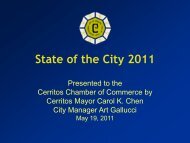Cerritos Recycled Water Distribution System - City of Cerritos
Cerritos Recycled Water Distribution System - City of Cerritos
Cerritos Recycled Water Distribution System - City of Cerritos
Create successful ePaper yourself
Turn your PDF publications into a flip-book with our unique Google optimized e-Paper software.
<strong>Recycled</strong> water process<br />
<strong>Recycled</strong> water is derived from a three-stage process. The first stage<br />
is primary settling, in which solid materials are removed from the<br />
wastewater as they settle to the bottom or float to the top <strong>of</strong> the<br />
primary settling tank. These solids are returned to the sewer to<br />
be treated at the main Sanitation Districts’ treatment plant. After<br />
primary settling, the water still contains dissolved and suspended<br />
organic material, which is removed in the second stage.<br />
During the second stage <strong>of</strong> the process, a dense biological culture<br />
<strong>of</strong> bacteria and microbes breaks down and feeds on the remaining<br />
organic material in the wastewater. After the organic material<br />
is consumed, the fattened bacteria and other organisms still<br />
suspended in the water form clumps and are carried into a final<br />
settling tank where they settle to the bottom and are removed<br />
and returned to the sewer to be treated at the main Sanitation<br />
Districts’ treatment plant.<br />
In the third stage, the water flows through filters composed <strong>of</strong><br />
anthracite coal on top <strong>of</strong> sand, which remove suspended particles<br />
that remain in the water. The filtered water is then pumped<br />
into chlorination tanks to kill any harmful organisms. It is then<br />
delivered to the <strong>City</strong> and its customers for landscape irrigation.<br />
More than 99 percent <strong>of</strong> the suspended solids and color are<br />
removed during the three-stage treatment process. After the water<br />
is treated, it is suitable for public contact, but not drinking, and is<br />
monitored in accordance with Health Department requirements.<br />
Benefits to<br />
plant life<br />
Compared to drinking water,<br />
recycled water contains higher<br />
levels <strong>of</strong> potassium, phosphorus<br />
and nitrogen. These nutrients are<br />
excellent for plants, and reduce the<br />
need for fertilizer. <strong>Recycled</strong> water<br />
also has a higher salinity level, so<br />
the <strong>City</strong> has planted salt-tolerant<br />
landscaping such as tif green and<br />
paspalum vegetatum (Australian<br />
salt grass). Colorful gazanias and ice<br />
plants also thrive on recycled water.


